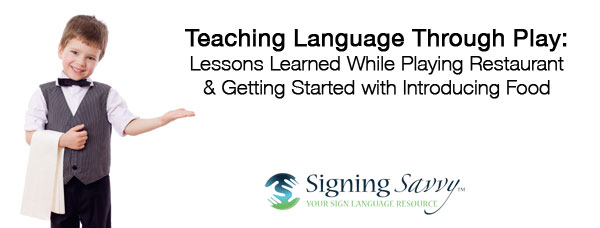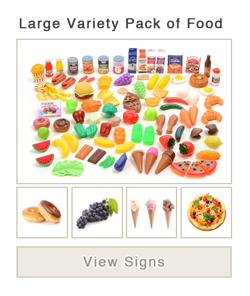
Teaching Language Through Play: Lessons Learned While Playing Restaurant and Getting Started with Introducing Food
Kids naturally learn while they are playing. Introducing activities that allow them to learn through play lets them explore their curiosity, have new experiences, and better connect and retain what they have learned.
Lessons Learned While Playing "Restaurant"
One great example of a learning through play activity is setting up an area to play “restaurant” in the classroom (or at home). Playing restaurant is a very successful way to cover several areas all at the same time – vocabulary, health and nutrition, math, time, professions, and manners.
Think about a restaurant experience, including:
- Choosing a restaurant
- Getting to the restaurant
- Parking the car
- Talking to a hostess
- Being seated or seating yourself
- Looking through the menu and deciding what to eat
- Ordering
- Setting the table
- Where the food comes from and cooking the meal
- The people working in the restaurant and what they do
- Serving the meal
- Table manners and eating
- How much things cost and paying
- Taking payment and giving change
- Feeling thankful and showing appreciation
Many lessons can all be taught through fun and interesting role play that involve tons and tons of lessons and vocabulary. These are all concepts that not only provide education related to curriculum goals, but allow the child to experiment in a safe environment and experience through play, which can help them be better prepared for real world situations.
One example of this is confidence building when ordering at a restaurant. It is not unusual to see young deaf teens that don’t feel comfortable enough in a restaurant environment to make their own order. Often their parents jump in and “rescue” them because they naturally want to protect their child from an uncomfortable situation. That is part of what this activity and lesson is all about. The more you educate and familiarize your students with these situations, the more prepared they will be to handle real world situations.
Through a series of blog articles, I will provide example lessons and activities related to playing restaurant. To get started, this article will discuss the first step of introducing food.
Lesson: Introducing Food
Take the time to introduce food through a formal lesson. I like to introduce real food and pretend food together. Allow the students to touch and taste the real food before they interact with the play food. Show them how to prepare it (do you have to peel it? remove seeds? cook it first?), ways to eat it, and examples of how to use it in dishes. You can share nutritional information and health benefits about the food. Anything you can do to expand their experience with the food will help them to remember both the signs and also any facts you teach about the food.
This is a fun activity that students will be excited to share with their parents. Letting parents know the signs used in this lesson will encourage them to keep the discussion through signing going on at home. If you are a member on Signing Savvy, you can create your own word list for this lesson or you can use one of our pre-built word lists (this can help outline your lesson plan also!). Then send the link to the word list(s) home to parents so that they can easily access them and learn them for themselves, or support the learning that happens at school (they don’t have to be a Signing Savvy member to view the signs in your word lists). Additionally, Signing Savvy members can use word lists to practice vocabulary through quizzes and digital flash cards.
Below are some posters and word lists to get you started.
Vegetables in ASL

Signing Savvy Member Feature: Download this image / flyer as a printable PDF page.
Corresponding Wordlist: Vegetables in ASL poster wordlist
Fruit in ASL

Signing Savvy Member Feature: Download this image / flyer as a printable PDF page.
Corresponding Wordlist: Fruit in ASL poster wordlist
Supplies Needed
Unfortunately, we can’t always have access to a variety of real food to taste test in the classroom! To get students engaged in this activity and to prepare for future restaurant play-based lessons, it is important to establish a good supply of pretend foods that would cover not only the food groups, but also be able to make up meals that would cover breakfast, lunch and dinner. It is good to have a variety of pretend foods, even if there is some overlap, to be able to show your students that the food they consume can come in different colors and sizes (a cut up carrot as opposed to a whole carrot or even a shredded carrot; OR the fact that a whole peach looks much different than a sliced, peeled, or canned peach).
Below is a list of many great options you can purchase directly off Amazon to get you started. Some of them even come with different lesson suggestions and activities you can do with your children as well. We’ve also created pre-built wordlists of signs to accompany each set of play food.
Peel N' Play Veggies Playset (By Small World Toys)
 |
|---|
Farmers Market Color Sorting Set (By Learning Resources)
 |
|---|
Cutting Food & Fruit Sets (By Melissa and Doug)
 |
|---|
Tote with Fruit & Veggies (By New Sprouts)
 |
|---|
Healthy Dinner Set (By New Sprouts)
 |
|---|
Grocery Basket with Fruit & Veggies (By Casdon)
 |
|---|
Large Variety Pack of Food (By Liberty Imports)
 |
|---|
Fast Food & Dessert Play Food (By Liberty Imports)
 |
|---|
Burger, Hot Dog, Chips, & Onion Rings Food Set (By Liberty Imports)
 |
|---|
Introduce your children to food and establish a good supply of pretend food, then watch for future blogs discussing other play-based lessons for your classroom restaurant.
ADVERTISEMENTS
 5 Tips for Creating a Language Rich Environment for Deaf Children Through Routines and Consistency
5 Tips for Creating a Language Rich Environment for Deaf Children Through Routines and Consistency Cooking Up Language with Signs: Frozen Fruit Popsicles Recipe
Cooking Up Language with Signs: Frozen Fruit Popsicles Recipe Avoiding Stereotypes with Gender when Teaching Sign Language
Avoiding Stereotypes with Gender when Teaching Sign Language






